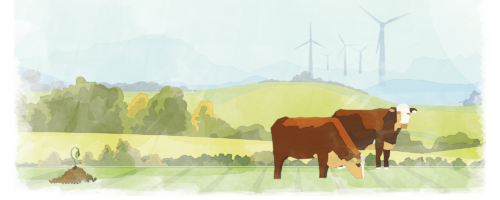Managing Pastures Before and During Drought
Pasture managers may dread droughts. However, with proper planning and preparation, they can minimize the damage and keep operations running smoothly.
“Periods of favorable rainfall conditions make everyone a better manager. Periods of drought conditions distinguish the better managers from the rest.”
Many philosophical statements come to mind when I’m considering pasture management during drought. One of my favorites of all time came from Mr. Wayne Hamilton, one of my range science professors at Texas A&M during my college years: “The time to start planning for a drought is when it is raining.” He followed that statement up immediately with: “And the time to start planning for a rain is during a drought.”
The bottom line is pasture management requires planning, and there is no substitute for planning ahead. Planning ahead has two aspects: a management plan for “typical” conditions and contingency plans, which should include a drought plan.
Think Ahead
The best means to prepare pastures for drought is good long-term pasture management before the drought. The fact is that well-managed pastures are more resilient during stress and recover more rapidly after stress.
In application, this means pastures are managed for adequate long-term residual and litter cover, soil fertility for introduced and cropped pastures is maintained at proper levels for expected production, pastures routinely receive adequate growing season rest and recovery, and stocking rate does not exceed carrying capacity. If these are performed well during favorable moisture conditions, the pastures will be in good condition when unfavorable conditions occur.
In today’s world, drought conditions in a region are usually forecast and certainly easily monitored as conditions change. The Drought Monitor is an excellent tool to track soil moisture conditions. In addition, monthly average rainfall is tracked by county, and in Oklahoma the Mesonet system is positioned across the state and available to the public. Weather and climate tools such as these allow producers to stay informed about regional weather conditions, which helps with the planning process; therefore, informed producers should not be caught off-guard as drought materializes.
Prepare for the Worst
Drought preparation should include an appropriate contingency plan that involves strategies and activities that can be executed in an orderly fashion as adverse conditions persist. You should prepare inventories of cattle by class, stored forages and standing forage to be grazed as well as assessments of livestock water quantity and quality. It is also important to determine the period of time in which the herd could be maintained as is if drought conditions continue as well as the length of time the herd could be retained as the stocking rate is incrementally reduced.
You must answer these questions:
- What do I need to do to get to the next season of anticipated rainfall?
- What do I need to do to get to the next spring growing season?
- How can I accomplish this while limiting the long-term damage to the pastures caused by grazing livestock?
Take Action
Once drought settles on a region, you need to begin implementing your drought plans. Your first thoughts should be on assessing the available and projected forage production for projected time periods, developing a destocking plan to allow for a planned marketing strategy for existing livestock should forage demand exceed projected forage supply, and determining the critical dates by which management decisions need to be made.
Typically, destocking strategies include:
- Early weaning of calves.
- Marketing of growing cattle.
- Marketing of open and problem (poor udders, eye and feet issues, poor disposition) cows.
- Marketing of less uniform and poorer-performing cows with the intent of maintaining the most productive and uniform cows as the core herd.
Relocating the core herd to other regions of the country that are not under drought conditions is also an option. Rarely is feeding through an extended drought a wise economic decision, but it is an option. However, early identification and purchase of required hay supplies in bulk before drought is fully realized is usually much more cost-effective than waiting until hay prices become inflated.
The second item of business is to assess livestock water supplies. Pastures with unreliable or less dependable water supplies should be grazed early while water is not limited in quantity or quality. You should maintain adequate residuals in all pastures, especially the native grass pastures, where recovery is longer and more difficult to achieve than in introduced pastures. If pastures are to be grazed harder or shorter or used as a “sacrifice area,” target introduced pastures such as bermudagrass, which – with fertility, weed management and moisture – can recover quickly. Avoid overutilization of native pastures.
Third, manage the grazing by rotating the remaining cattle through pastures, monitoring closely the projected number of grazing days (weeks) ahead of the herd and the recovery rate of the pastures. If grazing expectations are not being met without overutilizing the pastures (grazing into the desired residual), destocking protocols should be further implemented. Avoid “throwing open” all the gates. Manage the grazing, recovery and residuals in the pastures throughout the duration.
If drought conditions manifest during the peak rainfall periods of spring and early fall, early and timely implementation of management practices are of greater importance to meet projected production goals. You should apply fertilizer, especially nitrogen fertilizer, early at an adequate but conservative rate. You should perform establishment practices early in the season, and only on the amount of acres that can be well-prepared ahead of planting. Apply herbicide only if the target weeds are actively growing and not drought-stressed, usually early in the season. Make weed control a priority over fertility on introduced pasture if one must be chosen over the other.
A good management practice during drought is to plow and maintain fire guards/breaks along fence lines around the perimeter of your property and pastures (including hay storage traps and barns), especially along the south borders that adjoin county roads. With prevailing southerly winds, the south boundaries are the most likely to be threatened with wildfires. This is a means to protect forage supplies in pastures during times when they are of the most value to your operation. In addition, regular planned use of prescribed fire on native pastures helps reduce buildup of plant material for wildfires to consume, aiding in suppression.
Have a Safety Net
Finally, participating in the USDA Risk Management Agency’s Pasture, Rangeland, Forage (PRF) insurance program can provide some assistance during droughts. The PRF insurance program is designed to provide coverage on your pasture, rangelands and grazed forage crops. It gives producers the ability to cover replacement feed costs when a loss of forage for grazing or harvest is experienced because of lack of precipitation, not just during extreme drought.
Sign-up for the program is annually and occurs in the fall preceding the year of coverage. PRF insurance is supplied by local and regional independent insurance agencies and is well worth considering if you are a producer with grazing livestock and hay. It may not alleviate drought conditions, but it can make them easier to live through.
However, keep in mind that the best drought insurance for pastures is good long-term pasture management before and during the drought.



Comment